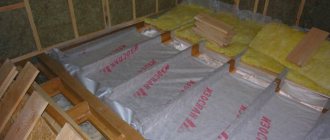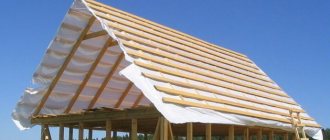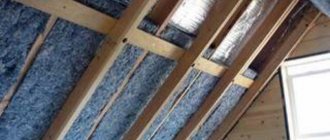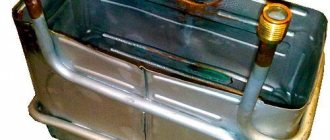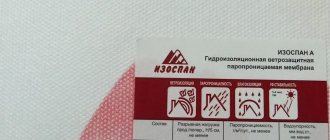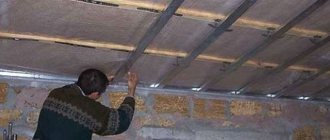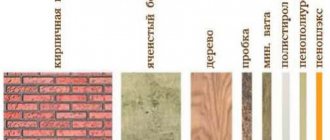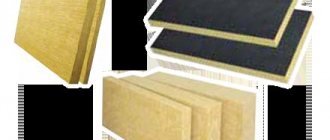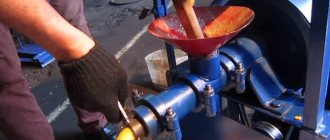Izospan is an insulating film coating. The main purpose of the film is to ensure that the original thermal insulation characteristics are maintained throughout its entire service life. It is difficult to imagine a modern construction project without the use of various types of thermal insulation. Mineral wool, Penoplex, Izolon, Izover, various polystyrene foams and simply polystyrene foam - all these materials require their own protection.
Thermal insulation materials practically envelop our house, retain heat on frosty and rainy days, create comfort in the hot summer, preventing the penetration of heat flows. But how to protect the thermal insulation belt from negative atmospheric phenomena? Reliable protection from moisture, rain, damaging winds is designed to be provided by 100% polypropylene, with the proud name - Izospan .
To create a barrier at the stages of the construction process, to perform the function of protective insulation for thermal insulation, this is the true purpose that isospan vapor barrier successfully fulfills. Despite its apparent simplicity, the material differs by type.
We bring to your attention – Izospan instructions for use. Figure it out: which side to lay the isospan on. Consider the isospan technical characteristics, and the installation method.
Worthy competitors of isospan:
- Tyvek vapor barrier;
- Vapor barrier TechnoNIKOL;
- Vapor barrier Nanoizol;
- Vapor barrier Ondutis;
- Vapor barrier Yutafol.
Before moving on to a detailed review, it should be clarified that the films are presented by the manufacturer in a wide variety and have different purposes. Vapor barrier films and membranes are divided into absolutely vapor- and water-tight and partially permeable to moisture only in one direction. Some of the materials successfully complement thermal insulation, enhancing its characteristics.
Application of Izospan
Izospan is a non-woven membrane or film that is used as part of insulating structures to protect the heat insulator from moisture, as well as wood and metal elements from rot and corrosion.
In construction, Izospan roof waterproofing is used, which is attached directly to the rafters under the sheathing, and a vapor barrier for installation from the attic side, in order to protect the fibrous insulation from moisture accumulation. Also, vapor barrier film is used for insulation of attic floors, floors and ceilings, and thermal insulation of walls on the room side.
For the walls of a wooden building that is insulated from the outside, a vapor-permeable membrane is used, which protects the fibrous heat insulator from weathering and does not prevent the escape of steam.
Example of use in an insulated roof
Types and purpose of material
Before buying material, you need to understand what types of Izospan the manufacturer offers, their features and purpose. The range includes rolled materials made of non-woven fabric and film, including those with additional coating. Installation of Izospan is carried out depending on the purpose of a particular type of product.
The characteristics of Izospan vapor barrier of different types have significant differences. According to the classification, three types of materials can be distinguished
:
- hydro- and windproofing membranes;
- hydro- and vapor barrier films with different properties;
- vapor-tight roll materials that promote heat conservation.
Groups of materials of the Izospan trademark
Each type of Izospan has several versions. All have letter markings, which simplifies the choice at the point of purchase and helps to understand how this or that material should be used. You can read more detailed instructions in the user manuals.
Manufacturer company
All categories of Izospan are manufactured by Izospan, which has its own production facility in the Tver region. The company produces various membrane films with vapor barrier, moisture-repellent and energy-saving properties.
Products undergo strict quality control at all stages of production and have international certificates of conformity. Thanks to these features, the products are in consistently high demand in the domestic and European markets.
Vapor-permeable membranes for waterproofing and wind protection
A membrane made of non-woven fabric for creating waterproofing, vapor-permeable barriers is developed for external work on thermal insulation of roofs and wall structures. The material does not allow moisture to pass through and is able to protect the insulation from the effects of precipitation and wind.
In addition to waterproofing the insulation, the diffusion membrane performs another function - it prevents condensation of moisture entering the fibrous heat insulator through the walls of the building along with steam. The steam is quickly released outside, so that wooden structures are not threatened by fungus, and the insulation does not lose its thermal insulation properties.
Example of ceiling vapor barrier
Diffusion membranes are made of polypropylene. Their use is safe for human health and prevents the appearance of fungus. Scope of use
:
- insulation of pitched roofs with an angle of inclination over 35°;
- construction of frame houses;
- external wall cladding with siding or clapboard;
- hydro- and wind protection of heat insulation under ventilated facades.
Izospan A, AM, AS, AQ proff, A with OZD
The line of hydro-windproof, vapor-permeable membranes includes non-woven materials of various densities
:
- Izospan A (density indicator 110 g/m2) is the most permeable membrane of the entire line, it allows moisture to escape out, but does not let it in. When installing, it is necessary to leave a gap for ventilation.
- Izospan AM (90 g/m2) is a three-layer membrane. The technical characteristics of Izospan AM allow the installation of a protective hydro- and wind barrier without a ventilation gap, since air circulates between the layers of material and removes moisture.
- Izospan AS (115 g/m2) is also a three-layer diffusion non-woven material, but more dense than AM.
- Izospan AQ proff (120 g/m2) is a professional material. Izospan AQ proff has a three-layer structure with reinforced reinforcement. It is recommended to use Izospan AQ proff if externally insulated walls or roofing systems will have to be left for some time without an external protective and decorative coating. Features of Izospan AQ proff - increased resistance to moisture, ultraviolet radiation, and mechanical damage.
- Izospan A with OZD - the material differs from Izospan A in the presence of fire retardant additives. A non-flammable membrane is used if welding work is expected to be carried out in close proximity to an insulated structure, for example, when installing ventilation facades.
Be sure to read: Review of materials for roof waterproofing
Table of vapor-permeable membranes
Microporous membranes are made of two or three layers. Their characteristic feature is the different quality of the material on the front and back sides. One side is smooth, the other is rough. Hydro-windproof Izospan is laid to the insulation with the white side, if we are talking about Izospan AQ proff, AM and AS membranes
.
In this case, the diffusion barrier Izospan A and A with OZD, according to the instructions, is mounted with the smooth side out
. The accumulated condensate should flow along it into the drainage drain.
Waterproof and vapor barrier films
Waterproof and vapor barrier film is intended for indoor installation. It is used to protect insulation and structures from moisture, which increases the thermal conductivity of the thermal insulator and contributes to the destruction of wood and metal. The use of films that do not allow steam and condensation to pass through extends the service life of insulation and building structures if the installation has been carried out correctly.
Scope of application of hydro- and vapor barrier films
:
- arrangement of the floor base;
- installation of an insulated roof (protection of the material insulating a flat or pitched roof);
- insulation of building envelopes, sound insulation of partitions;
- protection of floors - basement, interfloor, attic (serves as a waterproofing barrier);
- laying wood-containing or wooden floor coverings (parquet boards, floor slats, laminate).
Laying vapor barrier on the floor
Izospan B, C, D, DM, RM, RS
The manufacturer offers a wide range of materials that serve as vapor barriers and waterproofing. All types of Izospan differ in density and functional purpose:
- Izospan B (density indicator 72 g/m2). Vapor barrier Izospan B is one of the most popular types of material due to its characteristics and affordable price. With its help, internal walls, ceilings with basement and interfloor ceilings, attics and attics under an insulated roof are vapor-insulated.
- Izospan S (90 g/m2). Concrete floors are waterproofed with film. The material is laid to protect the heat insulation on pitched roofs.
- Izospan D, DM (105 g/m2). Izospan D and DM are varieties of high-strength material. Brand DM has an anti-condensation surface. Izospan D, DM is designed for high loads. Izospan D and DM are primarily used for waterproofing flat or pitched roofs. The material is suitable for use as a temporary roof covering. Izospan D will also help resolve issues with a concrete floor or basement floor if the structures require reliable protection from moisture.
- Izospan RS (84 g/m2), RM (100 g/m2). Like Izospan D, these types of films are characterized by high strength. In particular, it is achieved due to the three-layer structure of Izospan RS and RM - a polypropylene mesh is located in the middle. Application of Izospan RS and RM - arrangement of hydro- and vapor barriers for ceilings, wall structures, floors, ceilings, for any type of roof.
The wide scope of application and technical characteristics of the materials Izospan D, C, B, Izospan RS and RM make them the most popular among all roll materials of the brand
.
Table of steam and waterproofing
Izospan D, like other representatives of the group, has two outer layers with different functions. One of the surfaces is smooth, the second is rough and fibrous. The roughness of the outer side contributes to the properties of the material to retain and disperse settling steam and condensate over the surface, allowing it to quickly evaporate.
High-strength fabrics (Izospan D, Izospan RS, RM) are treated with water-repellent compounds during the manufacturing process. The hydrophobic material is suitable for use as a waterproofing layer during the installation of earthen floors and cement screeds on a concrete base in wet rooms.
When installing a vapor barrier, it is necessary to lay Izospan with a smooth surface to the insulating material
. Depending on the operating conditions of the structure, it may be necessary to provide a ventilation gap of 40–50 mm to ensure moisture evaporation.
What is the canvas? ↑
If we compare Izospan with other cheaper analogues of vapor barriers, it is made not from polyethylene, but from 100% polypropylene. In addition, the material of the panel itself is reinforced and has two layers - smooth (rear) and rough (external).
This structure gives all the advantages: high strength and stability, the ability to remove moisture from the surface, close contact with the insulation.
In the production of Izospan, they adhere to the technology of melting the initial raw materials, followed by rolling and rolling on rollers, forming the residual thickness of the web and its structure.
But, such material has one drawback - its cost is higher in comparison with polyethylene analogues. However, high-quality vapor barrier coatings are well worth their price.
On a note
It is also worth knowing that although the film contains ultraviolet stabilizers, they do not eliminate the destructive effects of sunlight, but only slow it down. Therefore, the direct influence of UV radiation from the sun on the surface of the material should be excluded!
Heat-reflecting vapor-waterproofing materials
Among the Izospan materials, it is worth highlighting films on which an aluminum coating is applied using the spraying method. A feature of foil materials is the ability to reflect thermal radiation.
Be sure to read: Basalt thermal insulation boards - characteristics
Indoors, foil film is used to create a vapor-waterproofing barrier to protect the heat insulator, as well as to increase the energy efficiency of insulation. When installed outside the building, the foil material will protect the insulation from precipitation and weathering.
Using foil material in the attic
Izospan FB, FD, FS, FX
The group includes foil materials, the structure of which can significantly reduce heat loss in heated rooms. The specific purpose of materials marked Izospan FB, Izospan FS, Izospan FD, Izospan FX is selected in accordance with the characteristics of the base and coating.
- Izospan FB (density indicator 132 g/m2). The basis is thin, high-density construction cardboard. Izospan FB is equipped with a lavsan coating with aluminum coating on the outside. Area of use: covering ceilings and walls in saunas and baths. Izospan FB is capable of blocking up to 90% of heat rays.
- Izospan FD (132 g/m2). This is a woven base made of polypropylene with a layer of aluminum applied on one side. Izospan FD allows you to create a protective barrier along the ceiling and floor of the attic; it is used when installing a heated floor system, water or electric.
- Izospan FS (92 g/m2). The base of Izospan FS is made of non-woven fabric, on top of which foil is applied. Izospan FS is a rolled material that is not afraid of moisture, durable and easy to install. It is used as a roofing heat and vapor barrier for sloping roofs, as well as for frame walls.
- Izospan FX (145-175 g/m2). Izospan FX is distinguished by a foamed polymer base 2–5 mm thick with an aluminum coating. Izospan FX can be used as an independent heat insulator or mounted in combination with other types of insulation. Area of use: heat-reflecting, hydro- and vapor-tight cladding of walls, ceilings, and attics. Also installed as a heat-reflecting underlay under laminate.
In accordance with the instructions, materials such as Izospan FB, Izospan FS, Izospan FD, Izospan FX are laid so that the foil heat-reflecting side faces the room
.
Briefly about the main thing
To work correctly with Izospan, you must carefully study the instructions, as well as the product labeling. How fully the insulation will perform its functions will depend on which side the insulator is adjacent to the insulation. An error in location will cause the heat insulator to quickly fail.
Loss of the positive characteristics of the insulation will lead to the formation of an atmosphere in the room unsuitable for life. Expensive repairs will be required. After all, you will have to open the walls and completely change both insulators.
Installation of hydro-wind protection and vapor barrier on insulated pitched roofs
Taking into account the technical parameters of the material, Izospan grade A is used as waterproofing and wind protection for the insulated roofing pie of a pitched roof. To find out the required amount of material, you need to calculate the area of all slopes and calculate the number of rolls.
Laying Izospan for roof waterproofing (choice between grade A and similar types of material - AM, AQ proff) is carried out using the instructions
:
- At the preliminary stage, fiber insulation slabs are inserted between the rafters.
- Waterproofing roll material should be placed on the outside of the wooden roof frame in horizontal stripes, starting from the bottom.
- It is important not to confuse which side to lay Izospan to the insulation - place the waterproofing on the insulation with the white side without inscriptions.
- Laying is carried out with an overlap of the upper strip on the lower one by 15–20 cm, without tensioning the web, but also without allowing sagging - otherwise the material will make noise in a strong wind.
- During the laying process, the material is fixed to the rafters with staples using a construction stapler.
- The upper strip in the ridge part is mounted with a bend on the second slope; the instructions for use of Izospan indicate that it is advisable to avoid joining the strips in the ridge part of the pitched roof.
- Slats are stuffed along the rafters to create a ventilation gap (the thickness of the slats is 40–50 mm) so that air flows help remove moisture from the insulating layer. A self-adhesive sealing tape is first attached under the slats, and then the sheathing for the roofing is mounted on them.
- All joints and abutments of the waterproofing material to the structures are glued with mounting tape for sealing.
If Izospan DM is selected as a waterproofing barrier for an insulated pitched roof, the instruction manual requires that a ventilation gap be provided between it and the insulation. This can be done by placing counter battens along the rafters. In addition, ventilation holes must be provided at the roof ridge.
Roofing pie of an insulated pitched roof
A pitched roof, insulated with a fiber heat insulator, needs a high-quality vapor barrier on the side of the attic or attic so that moisture does not damage the insulation
. For these purposes, you can use a vapor barrier film of grade B or RS, or select a suitable foil material.
Be sure to read: Mineral plate for home insulation - technical characteristics
Let's look at how to properly install vapor barriers, following the instructions
:
- Izospan film grade B, RS has a smooth and rough side. It should be laid with a smooth surface towards the heat insulator, and a rough surface towards the room. When laying, the canvases are placed horizontally, overlapping, gluing the seams with a special tape. The material is attached to the rafters using brackets.
- Foil-coated Izospan is simple to use - usually there are no questions about which side to put the material on, since it is clear that the metallized side should reflect thermal radiation from the heat source in the room. The canvases are laid overlapping (FX-butt) and secured to the frame with staples. The installation instructions require the use of aluminum tape to seal the seams.
Insulated roof scheme
Selection of isospan tapes for different tasks
To properly install the Izospan vapor barrier of this brand, you will need one of the special accessories from the same manufacturer. Most of these adhesive tapes are double-sided tape, which is quite simple to work with:
- Izospan SL is a vapor-waterproofing tape-sealant with a double-sided adhesive layer, which must be secured using a metal strip.
- Izospan KL is an adhesive tape that has one side with a metallized coating.
- Izospan ML proff is a single-sided super-adhesive tape that is reinforced with fiber. It differs from others in its particularly high adhesion and is used for sealing vapor barriers on absolutely any surfaces: brick, concrete, metal, foam plastic and plaster.
By the way, it is precisely at this stage of work that many are tempted to purchase the most ordinary adhesive tapes instead of branded ones. Why not, you ask? But in fact, such tapes can withstand no more than three days of frost or heat. Here is a good overview of professional vapor barrier tapes, among which Isospan tapes take pride of place:
Now let's describe the entire process of installing a vapor barrier using these tapes step by step:
- Step 1. First you need to assemble a frame for the insulation - from timber, boards, slats and plywood.
- Step 2. Next, we cover the frame with wind protection, especially paying attention to the nodes around the pipes (if any).
- Step 3. We insert wool (mineral or stone) between the rafters, which will be held in this position due to its elasticity. In this case, the height of the wool should be 4-5 cm less than the height of the rafters.
- Step 4. After you have inserted all the insulation, foam all the cracks, dents and gaps. It is very important! Make sure that there is no possibility of cold bridges forming anywhere, and only then proceed to vapor barrier.
- Step 5. Now we spread Izospan vapor barrier sheets on the insulation. The vapor barrier film itself must be attached to the rafters without much tension, even with a sag of up to 2 cm, so that it does not tear later due to temperature changes.
- Step 6. Stick on a strip of fabric and tear off the protective layer. If you pass through a place where the integrity of the roof is compromised, for example, a window or an antenna, then you need to cut a hole and attach a vapor barrier using double-sided Izospan tape.
- Step 7. Press the second sheet of vapor barrier on top, press down and iron. If you have two strips of vapor barrier, then it is better to glue two tapes on them - for reliability. But Izospan FL metallized tape needs to be used to glue the joints of two layers of vapor barrier, right on top.
- Step 8. On the other side of the insulation, on top of the roofing cake, we stretch the hydro-wind protection directly along the rafters, and press it with counter-lattice bars.
- Step 9. We install the roofing covering, maintaining an air gap between the top film and the roofing covering. These ventilation ducts should be open at the window and ridge unit so that air can move freely there.
- Step 10. We close the vapor barrier inside with finishing finishing. Also, if you are making internal cladding with horizontal lining, then the vapor barrier can be mounted vertically, and the vertical panels can be sealed with butyl rubber tapes. And don’t skimp on tape for particularly difficult areas!
During work, make sure that dust does not settle on the vapor barrier; it is better to carry out preliminary cleaning for this purpose, otherwise the isospan tape will not adhere well. And if you have worked with insulation before, you will notice that there are always a lot of small particles and fibers left from it.
And the last step - make a careful inspection so that the tape fits tightly to the vapor barrier everywhere, there is uniform tension everywhere, and in general the work done should look neat.
We also present to your attention an unusual master class on installing Izospan vapor barrier, where two types of adhesive tape are used at once - Izospan KL and Izospan FL (just remember that you can work with such tapes only at a temperature of +5°C):
And finally, our last piece of advice when working with Izospan products: if we are talking about insulating an attic that is built on a wooden frame, a vapor barrier must be installed along the entire contour of the room: both on the roof and on the walls.
This is especially important if she has an open staircase, because then warm air from all over the house will accumulate in the attic, and it will become the warmest in the whole house. But in this case, water vapor will be drawn into the cooler lower floor (the air is always warmer in the attic), which is also not very good, although it is easier for installing a vapor barrier for the under-roof space. In this case, carefully consider the ventilation of the house, and in extreme cases, organize a separate staircase with doors for the stairs.
Installation of waterproofing for non-insulated pitched roofs
To protect the wooden elements of the frame of an uninsulated roof from precipitation, wind and condensation, it is recommended to use Izospan film grade D or DM (featuring an anti-condensation surface), as well as RM or RS as a wind-waterproof barrier.
On roofs of complex configuration, or taking into account further insulation of the roof, it is recommended to use vapor-permeable reinforced material of the AQ proff brand.
Since it is not necessary to insulate the roof before laying waterproofing, the material is immediately rolled out over the rafters and cut to size. The strips are mounted horizontally, from bottom to top, using a construction stapler with staples or nails with wide heads. The overlap at all horizontal and vertical joints is from 15 cm. Joints and junctions should be glued using a special mounting tape. Self-adhesive tape is installed over the flashing along the rafters to seal the attachment points. Counter battens are placed on top under a solid or sparse sheathing for installation of roofing material on the roof.
Roofing pie of an uninsulated pitched roof
Which side to lay the wind-waterproof barrier
:
- for films D, DM, RM, RS, the smooth side should be facing upward, towards the roofing;
- Membranes used as waterproofing, including AQ proff, are laid with the white side down.
The used waterproofing film D, DM, RM or RS additionally requires the installation of a ventilation slot in the roof ridge.
General provisions
- Laying films does not require special skills; it can be done independently, taking into account the individual characteristics of the membrane.
- The set of films comes with instructions; you must act according to its instructions. It is especially important to pay attention to the correct side of the attachment to the insulation.
- The material should fit snugly to the surface with a small gap in the corners (3-4 cm or more, if it depends on the design features). The canvases are overlapped relative to each other (at least 15 cm).
- Fastening to wood is done using a stapler; you should not forget about sealing seams and possible cracks using Izospan tape.
- For heat-insulating films, the metallized part should look inside the room, and the installation work itself is done end-to-end, without overlap. The seams are also sealed with metallized tape.
Installation of steam-waterproofing on insulated flat roofs
If a flat roof requires external insulation, use Izospan grade D or RM; it is also possible to use RS and C films. The material is rolled out onto a base of concrete slabs with an overlap of 15–20 cm. The choice of side of installation does not matter. To connect the strips to each other and to attach them to concrete structures, proprietary connecting tapes are used. Insulation and roofing are installed on top.
Pie flat roof
Installation of attic floors
It is important to use the right materials for arranging attic floors, choosing them depending on the operating conditions and purpose of use
:
- If it is necessary to protect the heat insulator in the ceiling between a heated room and an uninsulated attic from weathering and moisture, and to ensure the removal of vapors from it, AQ proff, AM or AS membranes are used. The sheets should be laid with the white side facing the heat insulator, close to each other, without gaps.
- A vapor barrier layer, which simultaneously protects against insulation particles entering the air, is installed on the side of the living room. Film grade B, RS, C or DM should be laid between the sub-ceiling and the finishing. The rough side should be facing down. It is advisable to provide a ventilation gap (40–50 mm) between the sub-ceiling and the vapor barrier.
Attic floor diagram
The vapor barrier on the room side of the rough ceiling can be mounted from foil materials. The reflective layer should face down
. A gap of 40–50 mm should be left between it and the finishing material.
All types of canvases are laid with an overlap of 15–20 cm, the joints and junctions are glued with mounting tapes appropriate to the material.
Description of materials Izospan allows you to understand the types of membranes and films, understand how to choose and how to install vapor and waterproofing.
How not to run into a fake, or where do such different reviews come from?
You will be surprised how among the majority of positive reviews about Izospan there are a few that are sharply opposite. Indeed, how can the same product perform remarkably well in the construction of one house, but completely disappoint in other hands?
In fact, the problem is not only whether the vapor barrier was placed on the right side and how tightly the joints were taped. Unfortunately, it happens that a person simply stumbles upon a fake, and one such underground workshop was once discovered even in Moscow. Therefore, when purchasing, pay special attention to the following markers:
A truly high-quality product does not cost much more than conventional films, but it completely solves all problems associated with vapor barrier!
